How to Dehydrate Celery
This post may contain affiliate links.
Celery is an often overlooked aromatic that brings a ton of depth and flavor to your soups, stews, and sauces. By making your own dehydrated celery, you will always have some on hand in the kitchen as well as the option to add it to your backpacking meals.
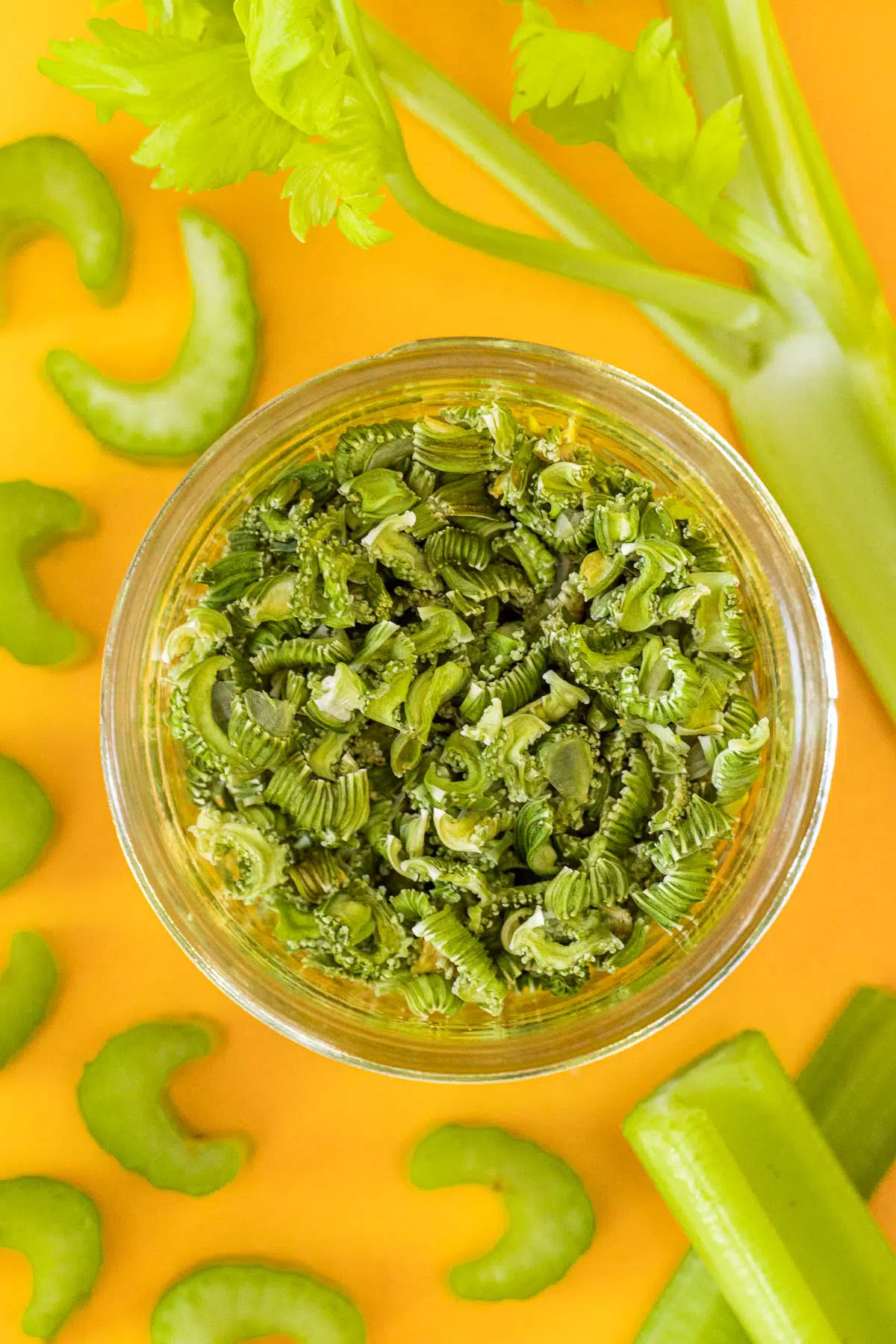
It’s true: nobody thinks of celery as a star ingredient, but this versatile aromatic plays a critical supporting role in many world cuisines. Celery is featured in French mirepoix (onions, carrots, celery), Cajun cooking’s Holy Trinity (onions, green bell peppers, celery), and as well as Italian Soffritto (onions, carrots, celery, garlic). Celery forms the foundation of many great dishes, which is why it’s nice to have some on hand.
While fresh celery is available at the grocery store year-round, it can only last for about a week in the refrigerator. That’s why it’s a great idea to dehydrate it yourself. Dehydrated celery can be added to soups, stews, and sauces and has a shelf life of upwards of a year.
Dehydrated celery is also a great way to elevate your backpacking meals. Try adding it to store-bought ramen or homemade dehydrated marinara sauce.
So let’s dive into how to celery your own celery at home, using a dehydrator or oven.
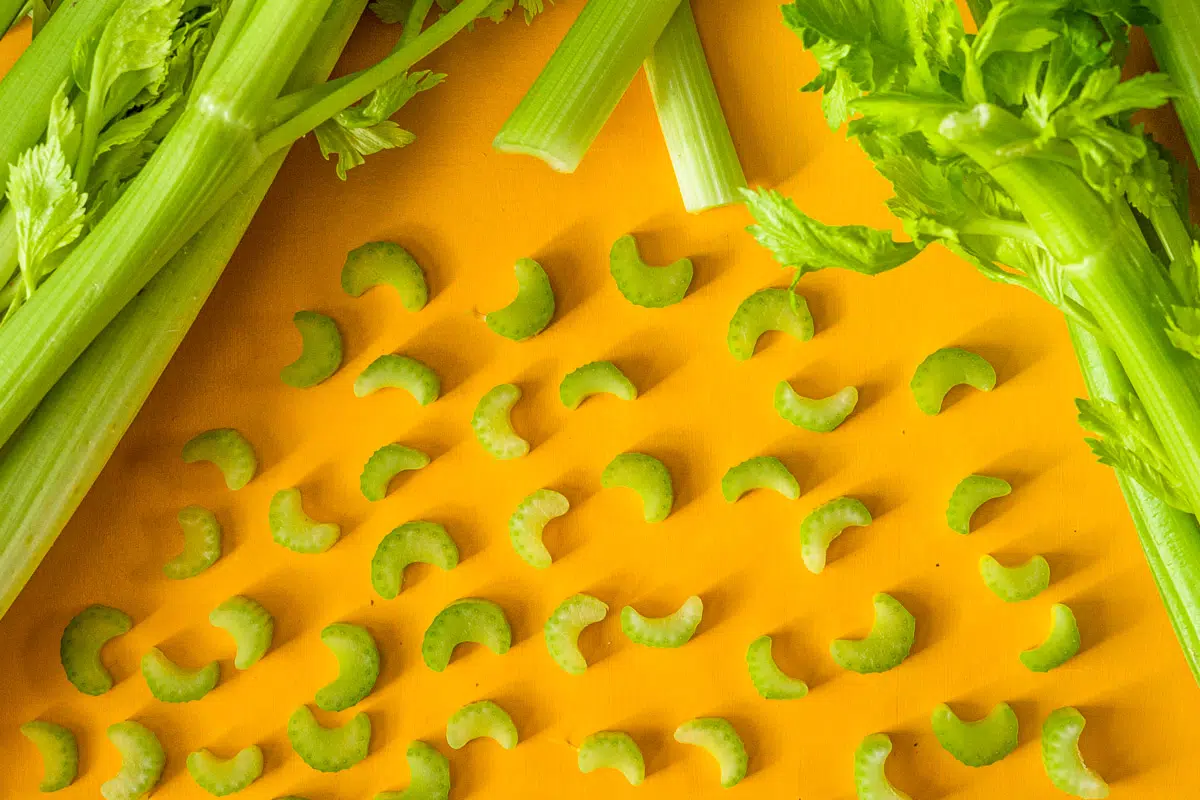
Prepping Celery for Dehydration
Before you start prepping your celery, make sure your counters, equipment, and hands are clean & sanitized to prevent contamination, which can spoil your batch down the line.
- Clean the celery: Thoroughly wash the celery and dry with a clean towel. Sometimes there can be a little dirt residue down by the base.
- Trim the ends: Trim off the broad, white base of the celery. Also, if any of the tops are dried and split, trim them off as well.
- Use a knife to slice into rounds: Slice your celery into crescents that are about ⅛” to ¼” inch thick, using a knife. (We’ve tried to use the mandoline for this, but celery is too long and flexible)
- Try to keep the pieces to a uniform thickness to help with even drying.
- Pre-treating (blanching): Briefly blanching your celery in boiling water prior to dehydrating will help it maintain its vivid green color for longer. It will also accentuate its sweetness while reducing bitter notes. However, it is an optional step. Bring a large pot of water to a boil. Add celery for 1 minute. Drain in a colander and then run under cold water to stop the carry-over heat from cooking the celery further.
Equipment Spotlight: Dehydrators
If you’re in the market for a dehydrator, we recommend buying one that has an adjustable temperature, which will allow you to dial in the drying temp to give you the best results for individual ingredients. The dehydrator we recommend (and use) most often is the COSORI Premium. You can also check out our best dehydrators post for a comparison of all the dehydrators we’ve used and would recommend.
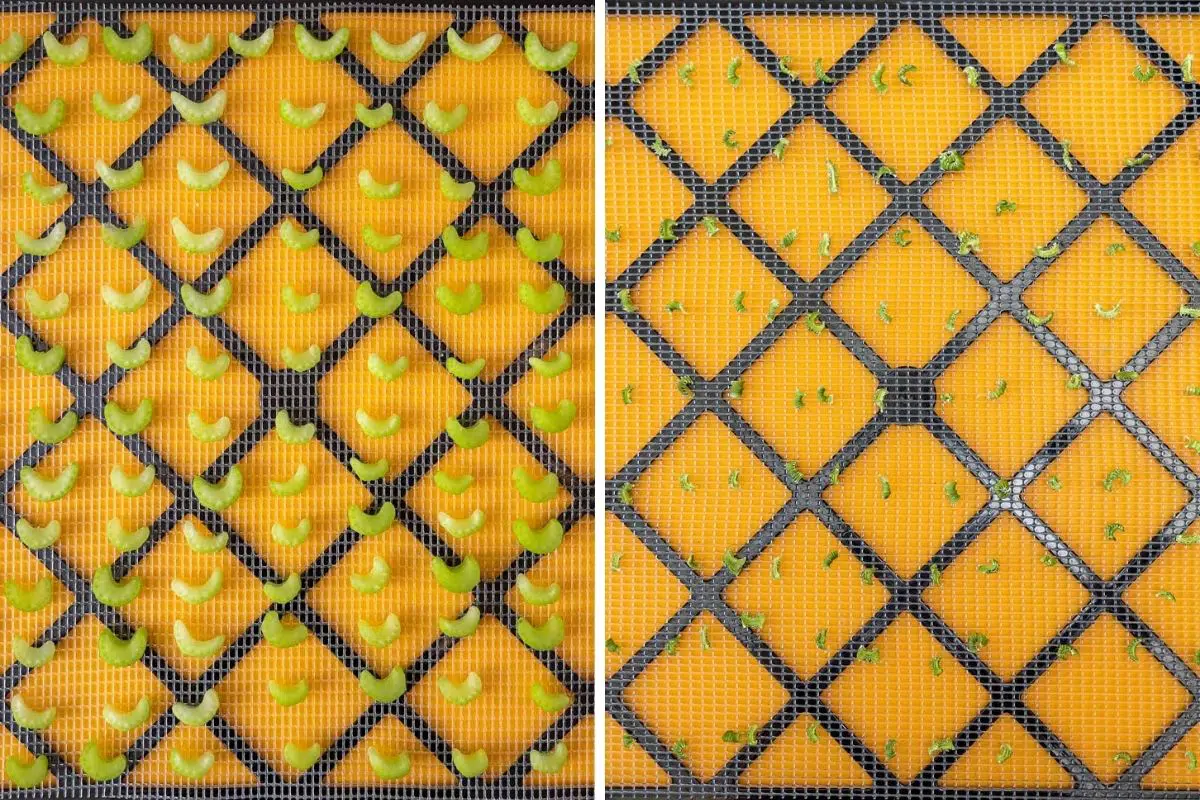
How to dehydrate celery
Dehydrating celery is super simple! Once your celery is prepped, set up your dehydrator and follow these steps:
Arrange the celery on your dehydrator trays. Use a mesh liner or parchment paper. Celery really shrinks down when dehydrated and will fall through most dehydrator tray racks. Leave space between the pieces to allow air to circulate.
Dehydrate at 125ºF (52ºC) for 4-8 hours until the celery is dry and brittle—they should break, not bend.
Depending on your machine, you may need to rotate the trays every so often to promote even drying.
How to tell when celery is done
Celery should be hard and brittle when it’s completely dried. To test, let them cool, then try to bend a few pieces. They should snap in half if properly dried. If they bend, put them back into the dehydrator or oven to dry longer.
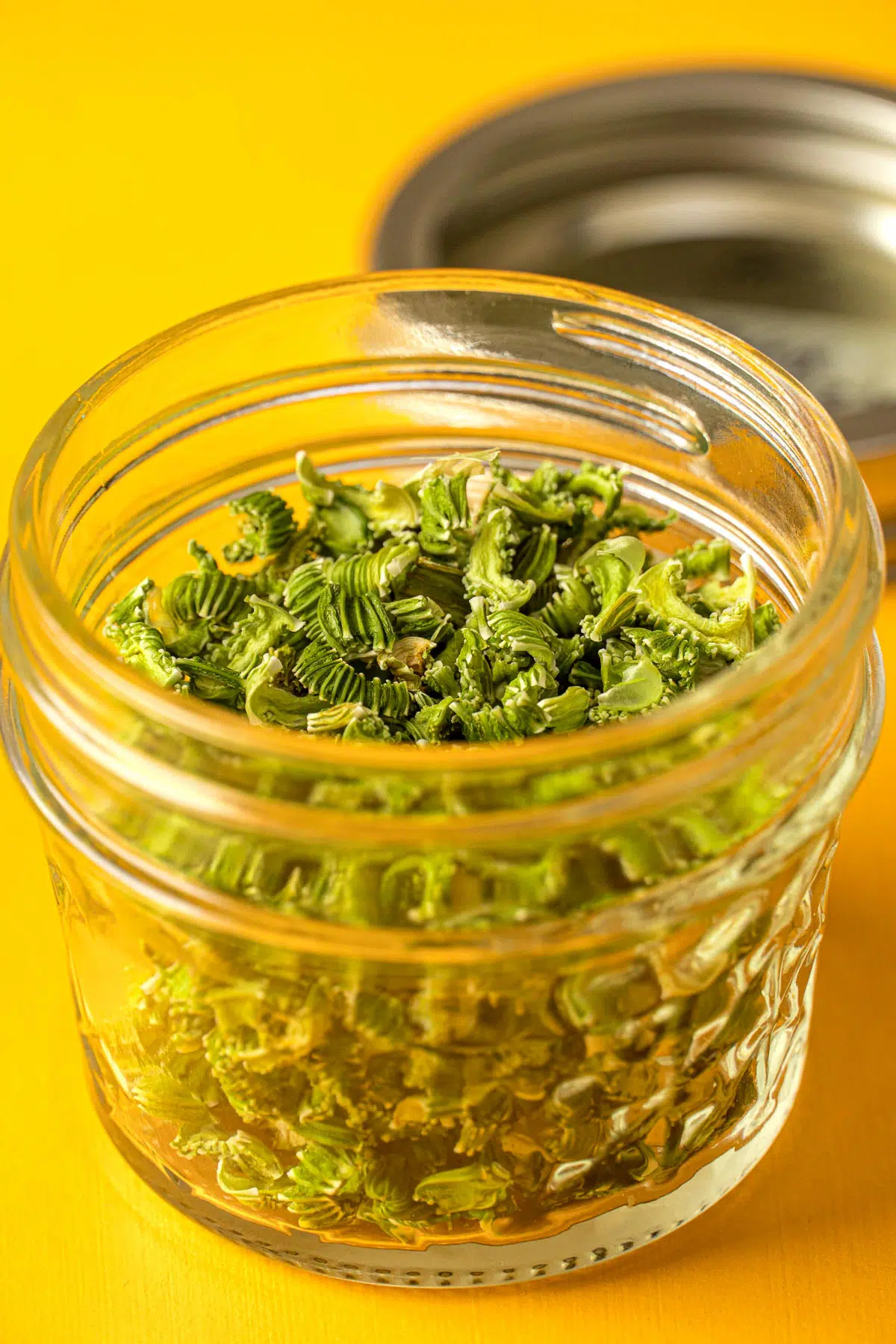
How to store
When properly dried and stored, dehydrated celery can last up to a year. Here are our tips for storage:
- Let the celery cool completely before transferring it.
- Condition: Loosely pack the celery in a transparent airtight container. Check it daily for a week to check for signs of moisture or condensation, and shake to help prevent the slices from sticking together. If signs of moisture appear, stick them back into the dehydrator (as long as there’s no mold—in that case, toss the batch). After a week, if there are no signs of moisture or mold, you can package them for long-term storage.
- Store in a clean, airtight container. For longer shelf life, vacuum seal.
- Use a moisture absorbing desiccant packet if you anticipate opening the container often, or if you live in an area with high humidity.
- Label the container with the date and any other important details.
- Place the container in a cool, dark, and dry place—inside of a pantry cabinet works well.
We personally like to store our dehydrated food in mason jars that have been vacuum-sealed using this handheld FoodSaver vacuum sealer along with these jar sealing attachments. This gives us the benefit of vacuum sealing without the waste (and expense) of plastic vacuum sealing bags. Since the jars are clear we make sure we store them in a dark spot in our pantry.
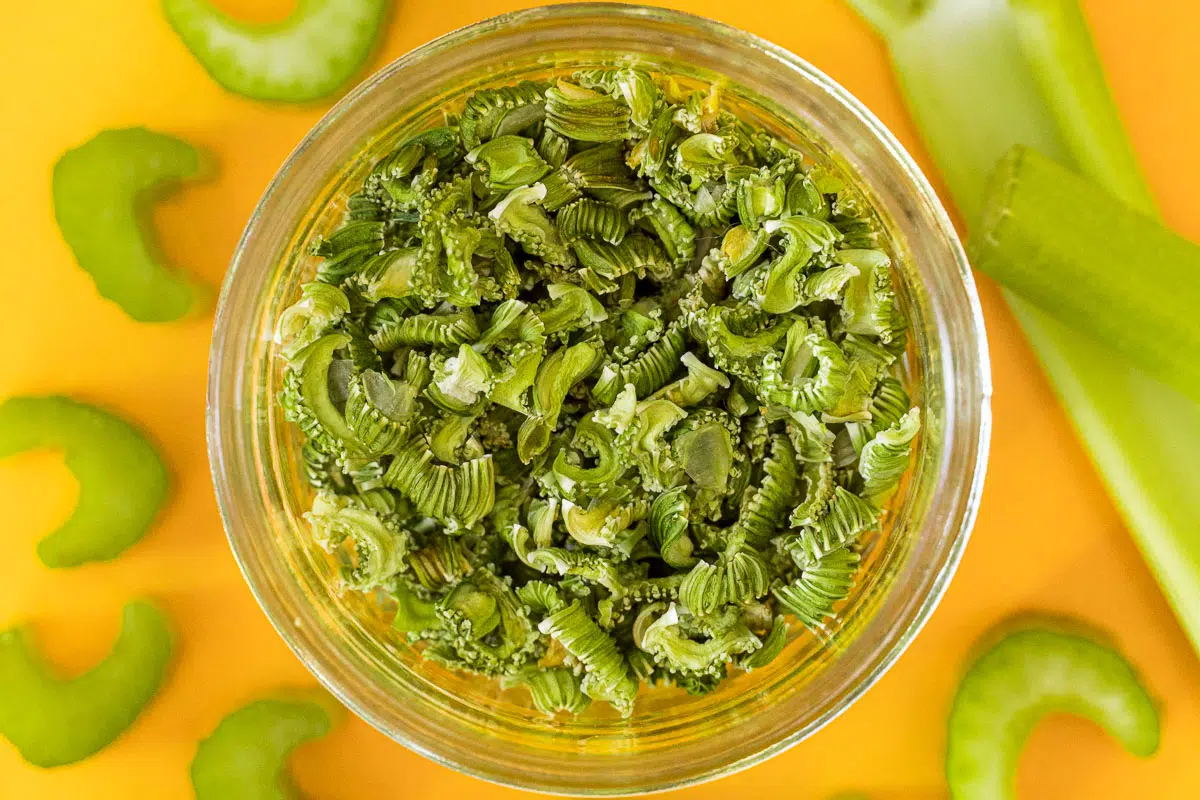
How to use
To rehydrate celery, place it in a bowl with boiling water and let it sit for 15-20 minutes. Or, add the dried celery directly into meals like soups or stews that have a lot of liquid and will cook for a bit.
While rehydrated celery works great for any application that calls for cooked celery, it will never take on the crisp, crunchy texture of raw celery. So it’s not the best option for salads.
- Add to homemade soups, stews, or casseroles
- Add to homemade marinara sauce
- Add to rice
- Add to store-bought ramen ramen
- Blitz it in a food processor to make your own celery salt (blend 2 teaspoons celery powder & 1 teaspoon sea salt)
- Use it in this Dehydrated Minestrone Soup for a hearty backpacking or camping meal
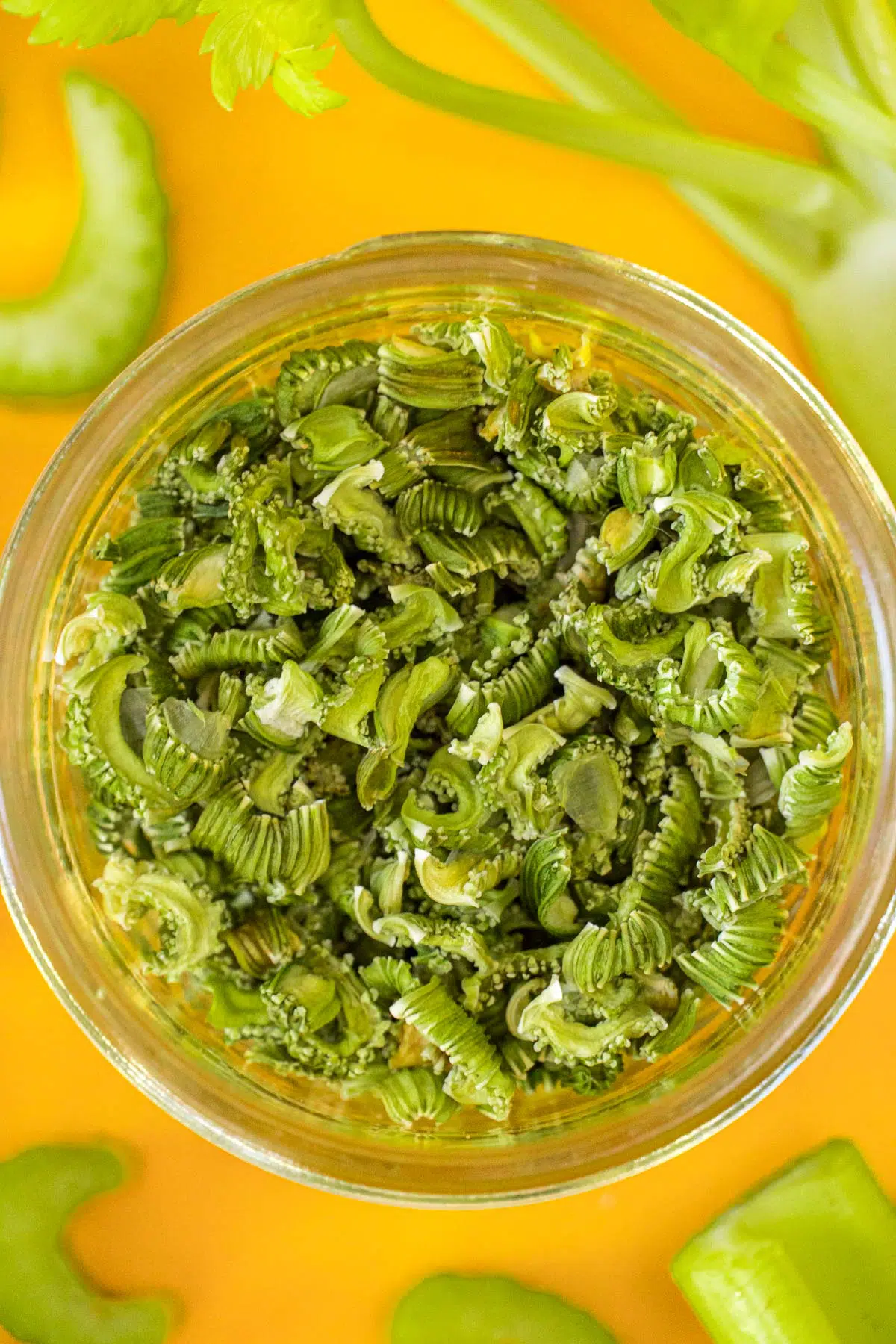
Fresh to dehydrated conversion
1 cup (4 oz/112g) fresh = 1 ½ tablespoons (5g) dried

Equipment
- Airtight storage container
- Vacuum sealer (optional)
Ingredients
- 1 lb celery, see note 1
Instructions
- Start with clean hands, equipment, and countertops.
- Slice the celery into ⅛” to ¼” pieces.
- Optional: Blanch for 1 minute in boiling water, then drain and run under cold water. Shake dry.
- Arrange the celery on dehydrator trays, utilizing a mesh liner to prevent the celery from falling through the holes as it shrinks.
- Dehydrate at 125ºF (52ºC) for 4-8 hours until the celery is dry and brittle—it should break, not bend (see note 2).
Storage Tips
- Let the dried celery cool completely before storing.
- Short term storage: If celery will be consumed within a few weeks, store in a ziptop bag or sealed container on the counter or in a pantry.
- Long-term storage: Condition by loosely packing the dried celery in a transparent, airtight container. Leave it on the counter for a week and check it daily for signs of moisture. If condensation appears, return the celery to the dehydrator (unless there are signs of mold—then, throw out the whole batch). Shake occasionally to keep the pieces from sticking together.
- After conditioning, store in an airtight container in a cool, dark place for up to a year. Vacuum sealing will help extend the shelf life and quality of the celery.

